Gdansk old town
When visiting Gdansk old town, you may feel that you are carried back to the Middle Ages, and even though substantial parts of the town consist of reconstructions from after WWII, you will still find plenty of authentic, genuine old buildings. Most streets are located where they were in medieval times, and more than 30% of the streets have had the same names for more than 500 years. The old town is one of Europe’s largest historical centres, and the medieval centre is around twice the size of the corresponding centre in Krakow. For those who have visited Krakow it is definitely worth trying to compare the styles; the way of building is quite different, influenced by the functional needs of a harbour town where the basements were used for storerooms and warehouses lay side by side, and obviously you also feel that this is an old Hanseatic town.
Dlugi Targ
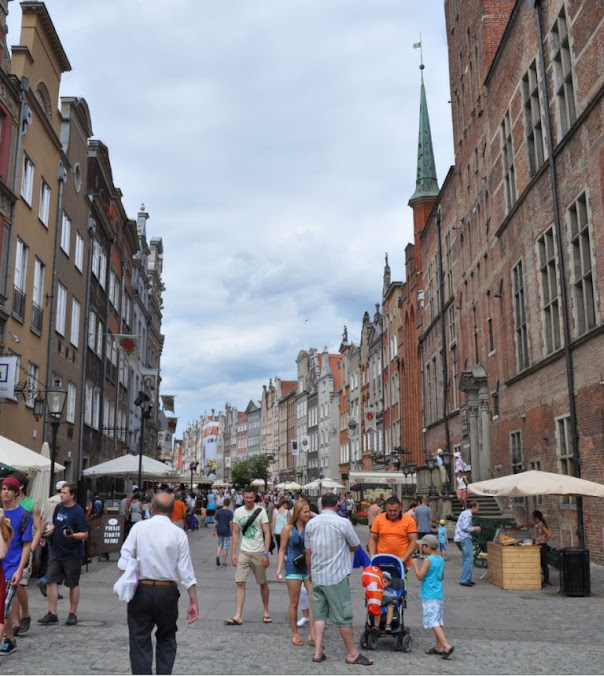
Dlugi Targ
Gdansk does not have a “Rynek” – or main square – as most other Polish towns. Instead the town has been equipped with a wide pedestrian street, Dlugi Targ (the Long Market), which runs from Targ Weglowy (Coal Square) to the channels. It’s something in between Las Ramblas in Barcelona and Regent Street in London. From an architectural point of view Gdansk resembles Copenhagen, Hamburg and to some extent, Amsterdam. A trip around Gdansk often makes me think about the canals in my native Copenhagen, but only until I get the bill for my beer. A pint of lager is substantially cheaper in Gdansk than in Copenhagen.
Dlugi Targ lies where it has been lying since the Middle Ages, and from day one this has been the centre of trade and important decisions in Gdansk, no matter if the town has been under German or Polish jurisdiction. The route through Dlugi Targ is also referred to as the Royal Route.
As previously mentioned, the street starts by Targ Weglowy. The fence post is Zlota Brama (the Golden Gate) that was erected in1612 and designed by the Dutch architect Abraham van Blocke.
By and large the street was totally destroyed during WWII, but most buildings are exact reconstructions of the original houses. The street is a mixture of late Gothic style and baroque, with substantial influence from Dutch architects and artists. Buildings in the same style are seen in South German and Dutch towns; normally they should have become slightly sloping as time went by, so the ruler-straight walls make it obvious that the buildings are rather new, but even then the architecture gives you a thrilling experience and allows your imagination to move back to ancient times.
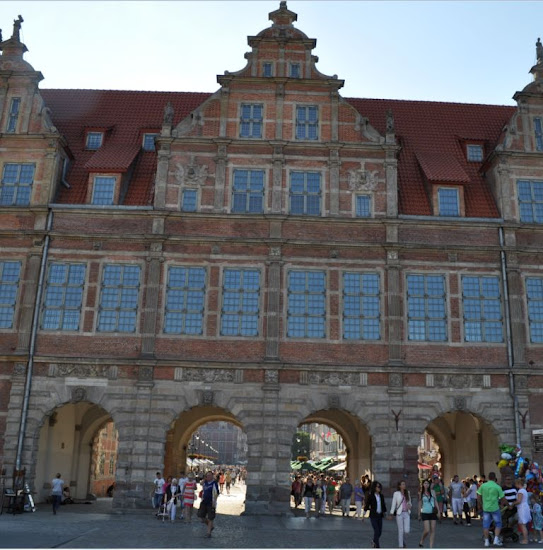
The Green Gate in Gdansk old town, seen from the waterfront. The former royal residence.
Dlugi Targ ends at Brama Zielona (the Green Gate), which leads to the channels. The palace dates back to 1568 (a reconstruction), and was erected by Regnier from Amsterdam in Dutch style. The palace was originally designed to serve as a residence for Polish kings, but no Polish king ever stayed overnight in the palace. Today the building is used by the National Museum in Gdansk.
At Dlugi Targ something will be happening all the time. Tourists as well as locals meet up in the bars or gather around the street performers, who are active from April to September. It’s a good feeling to sit in the square enjoying the atmosphere, but to find a place with more local character you may want to turn into the side streets and walk down into the cellars.
Even if Dlugi Targ is crowded during the day and in the evening it empties before midnight, where nightlife should be found is in the above-mentioned side streets and cellars.
On the way along the street you will among other things notice the Gothic town hall, the Neptune fountain and a wealth of impressive town houses. In particular it is worth paying attention to:
The City Hall

The old City Hall
The construction of the present Town Hall was initiated in 1379, when the town was dominated by the Teutonic Knights. In the following centuries Gdansk returned under Polish jurisdiction, the town flourished and the Town Hall was enlarged. The style is Gothic, with elements from the renaissance, which have been added later. It is an impressive building, including 5 tall storeys and a tower rising 83 meters into the air; at the very top stands a gilt statue of King Sigismund Vasa (1548-1572), who stands there taking a look across the town.The building was badly damaged during Soviet bombings in 1944, but the walls were saved and after the war the town succeeded in reconstructing the destroyed parts. The Town Hall is today the headquarters of the Historical Museum of Gdansk, and it is open to visitors. A walk through the magnificent halls is absolutely worth it.
The Neptune Fountain in Gdansk old town
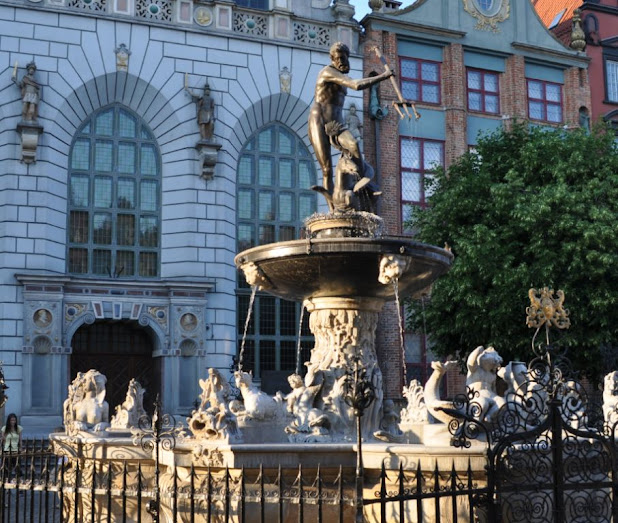
The Neptune Fountain is situated right in the middle of Dlugi Targ and no doubt belongs to the most often photographed objects in Gdansk.
The Neptune Fountain of 1633 was commissioned by the city council of Gdansk, which wanted to equip the town with a representative fountain connected to the Town Hall. Like many other of the town’s architectural masterpieces, the fountain came into being thanks to a group of artists of Dutch origin (whereas the architecture in Warszawa and Krakow tend to be rather inspired by Italian architects). The fountain and Neptune himself were designed by Abraham van den Blocke, while the moulding was made by Piter Husen and the actual bronze casting was carried out at a local foundry in Gdansk.
Dom Uphagena (the house of Uphagen)
The merchant Jan Uphagen acquired the building in 1775, whereupon he spent the next 12 years renovating the building – indoors as well as the facade – with the help of the architect Jan Benedykt Dreher. The result was a magnificent town house, which the childless merchant transferred to a foundation, which was supposed to keep the building unchanged. Since the year 1900, the building has been open for the public, and even if it was destroyed during WWII, around 40% of the original interior was saved, enabling the reconstruction with the use of elements that survived the war. A visit to the house will thus show you how wealthy burghers lived in the 18th century.
Stagiewna Street – the Marina – Dlugie Ogrody – Lower Town
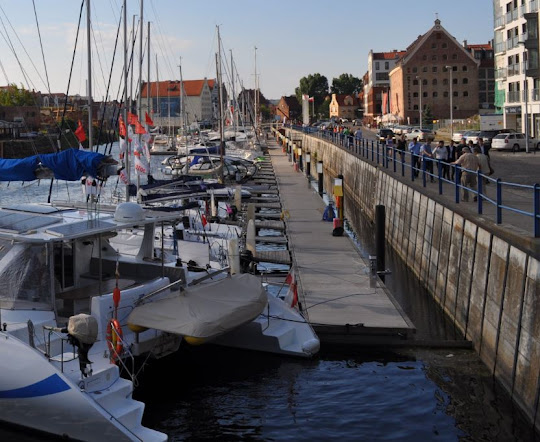
The marina in the centre of Gdansk
After having walked past the Green Gate, you may choose to continue straight ahead past a small channel bridge that leads to the newest reconstructions of the old Gdansk. On the one side you will see a row of beautiful old style small town houses erected in 1999, and at the end of the street, a genuinely old, round defence tower from the 15th century.
There are lots of hotels, shops and small restaurants in the area, and if you turn left, you will reach the most charming marina, where you will also find the microbrewery, Brovarnia Gdanska.
Instead of turning left, you may decide to walk straight ahead down Dlugie Ogrody (the Long Gardens). This area was until a few years ago known as one of the rather tough places in Gdansk, and the atmosphere is also still more local than in Main Town. Grey communist concrete mixed up with modern architectural gems and a few brick houses from before WWII. The whole street, from the beginning of Dluga Street to the end of Dlugie Ogrody may be considered as one, long route, and this was also the way the streets were considered in the middle ages.
On the right you will find the Lower Town (Dolne Miasto) – an industrial area from the 19th century. By and large the quarter was not affected by WWII; for this reason you may see a large selection of factory buildings and blocks of flats from after 1850. The area wasn’t well maintained after 1945 so many of the buildings are in a state of decay, which obviously influences the rent to be paid as well as the local dwellers. You can easily take a walk through the area, but you had better not provoke others by looking too much like a tourist, or click the camera non-stop – this may not be well received by the local residents. Nevertheless, you will also find well-kept buildings, and a walk through the area gives a good impression about the town before the war.
Back at the Green Gate. If we arrive from Dlugi Targ, we can also turn left, which brings us into the channel area. The old buildings are absolutely marvellous and the atmosphere is relaxed. Even though the harbour side is dominated by tourists, it all seems real, which shows that they have succeeded in creating an authentic harbour front.
Along the channel you find the authentic gates leading you into the Old Town of Gdansk. The old crane of 1444, flanked by two historical towers, is especially worth seeing. The crane has a lifting capacity of 4 tons, thus belonging to the most powerful cranes of its epoch. From the pedestrian area along the channel you can look right over at the other side, where you will find the philharmonic and the marina, and obviously you can also have a look at the ships in their own element. During the summer season there is a ferry connection to Sopot, Gdynia and Hel.
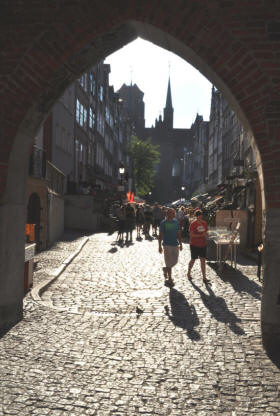
Through the gate to Mariacka Street
Several minor streets take you from the channel area towards the centre; one of them is Mariacka Street, often referred to as one of the most beautiful places in Poland. The narrow, cobbled street is surrounded by narrow three-storey town houses in a variety of discrete colours and the street itself is closed off by an old brick house with a gothic arcade leading to the channel area. At the other end of the street, the impressive Mariacki Church rises up towards the sky. At street level, the ground floor premises and the basements have been converted into cosy cafés and boutiques selling amber, to such an extent that the street is said to be Poland’s amber centre.
The street’s beauty does not originate only from a special beauty of its buildings, even though obviously the amber shops give a bit of splendour. The main characteristics are the closed form and the view to the massive church, and then the traditional houses, all equipped with a small terrace in front of the building, formerly a distinguishing feature in the architecture of Gdansk, but now only preserved in a few places in town.
St. Mary’s Church – the Gdansk Cathedral
With 82 meters to the highest spire, the church rises up in the landscape amongst the small streets and squares surrounding the cathedral. The church has a surface area of 5,000 square metres, and so it belongs to some of the largest churches in Poland, and it is actually the world’s biggest brick church in the Gothic style. It is a formidable church, which must be experienced to get the right impression of its dimensions.
The church was built as a Roman cross, with high, oval leaded panes. In spite of several reconstructions, the Gothic architecture remains, and the red bricks bear witness of another epoch.
The inside of the church looks relatively modest, taking into consideration that it is one of the most well known churches in Poland, but if you walk around and take a good look at the individual parts, you will experience unusual riches in the detail and beauty. The slightly less grandiose adornments might be a leftover from the many years when the church used to be protestant in the mainly German Gdansk.
There has been a church at this place since (it is believed) 1266; the present church was built from 1343 but the building has been enlarged several times, and it was finished in the form it has today by 1502. In 1945, the building was partly destroyed by artillery fire, and it had to come through extensive reconstruction before it was once again ready for use in 1955.
Targ Weglowy (Coal Square)
The main pedestrian street – Dluga – leads into Zlota Brama and Targ Weglowy. It is one of the most dynamic squares in Gdansk, with several fashionable bars, a theatre and a medieval prison.
Katownia (the dungeon) – the medieval prison used to serve as a courtroom, prison and an area where corporal punishment was executed. In addition, a pillory was placed in front of the prison, where also death penalties were carried out.
Zbrojownia (armoury) – maybe the most conspicuous building in the square. The armoury was ready in1605 and was the answer to an ever increasing threat from the Swedes. It was erected with Dutch red bricks, richly ornamented and equipped with gilded figures on the top of the building. It burned down in 1945 but was re-erected in the original style after the war. Right next to the armoury, one of the old defence turrets is placed, and later on this served as a storehouse for gunpowder.
Drzewo millenium – (the millennium tree) marked the 1000th anniversary of Gdansk in 1997. The tree is made in metal by the artists Wojciech Schwartz and Leonard Dajkowski and it symbolizes the solidarity between the countries of the world.
At the square you will also find a theatre as well as the Academy of Fine Arts in Gdansk and the square is a popular place for organizing concerts, markets and other arrangements; in general a great place for a walk and for meeting new people.
The Shipyard
The Gdansk Shipyard has become a symbol of the town – it started functioning just after WWII on the area formerly occupied by a German shipyard, and it quickly became a symbol of Poland’s resurrection from the destructions of the war. During its existence under communist rule, the shipyard built a large number of different ship types, from cargo vessels and trawlers to ferries and yachts, and this way it became a plant with strategic importance for the country because of the significant export, bringing foreign currency to the country – a much needed commodity in Poland at that time.
The shipyard workers were relatively well treated in communist Poland, where workers in strategic industries like mining and heavy industry had the best working conditions. Maybe this is the reason why these groups seemed to possess particular self confidence at least it was here that the political unrest arose in post-war Poland. The workers at the Gdansk Shipyard had several serious fights with the government when economic crises limited their spending power. One of the more serious clashes with the government was in 1970, when military units opened fire and killed a number of striking shipyard workers. Ten years later, workers under the leadership of Lech Walesa occupied the shipyard and won the right to form the free trade union Solidarity, which was not controlled by the government. This happy state of affairs lasted until martial law in 1981, but Solidarity and Lech Walesa had already established themselves as political opposition, and the leaders of the country did not have the necessary political strength and will power to extinguish them. The political activity that spread into all parts of Polish society had its roots at the shipyard, and it was also from this place they succeeded in forcing through the democratic changes in 1989. The strike in 1980 was depicted in the extraordinary movie The Iron Man, by Andrzej Wajda in 1981.
When passing the shipyard from the main road, the railway or the channel you will clearly see the enormous heavy weight cranes standing one next to another in immovable majesty, giving a clear impression of the activity which once took place on this huge terrain. In front of the main entrance we notice a number of historical symbols from the labour disputes, and in front of the shipyard we find an old residential district with original bricks from around 1900. This is an area with a lot of charm, and it gives a fantastic impression of the city’s life, also the period before WWII.
After 1989, the shipyard has lived through hard times and several bailouts, which have often been included in the national political plans because of the shipyard’s symbolic significance in the breakdown of the communist system. The activities taking place at the area have now been thoroughly diversified, the workforce has been decimated, and the company has stopped producing ships. However, ship bottoms are still produced and there is a relatively large repair shipyard. For the rest of the area, they have started to sell off parts of the land for different purposes, and also a number of cultural activities take place in the area.
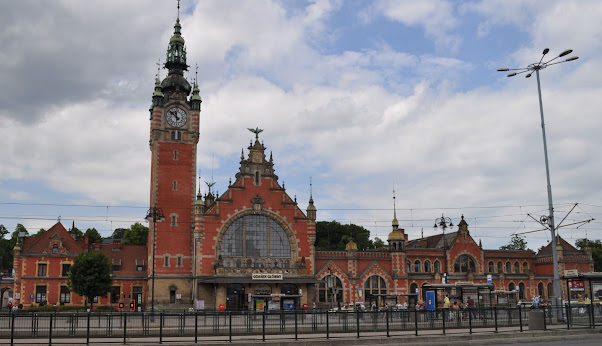
The main railway station
The main railway station in Gdansk is located on the edge of the old town, a 10-minute walk from the shipyard, and at a very short distance from some of the largest hotels in Gdansk. The building was burned by the Red Army in 1945, but they still succeeded in saving the outer walls, and the Main Station anno 2013 reminds us very much of the grandiose station that was finished in 1900. It was erected in a mixture of renaissance and baroque, and this mixture of styles gives the building a very special look.
The building and the area around it is the main junction in Gdansk, with the bus station placed just above the rail station and local buses plus trams at the main road in front of the station. And last but not least, the urban railway connecting Gdansk with Gdynia and Sopot has its terminus here.
The area around the rail station is filled with life, from the distinguished visitors at the luxury hotels to less distinguished groups united in a common interest in cheap, locally produced drugs; but most people are local residents on their way to and from their everyday doings.
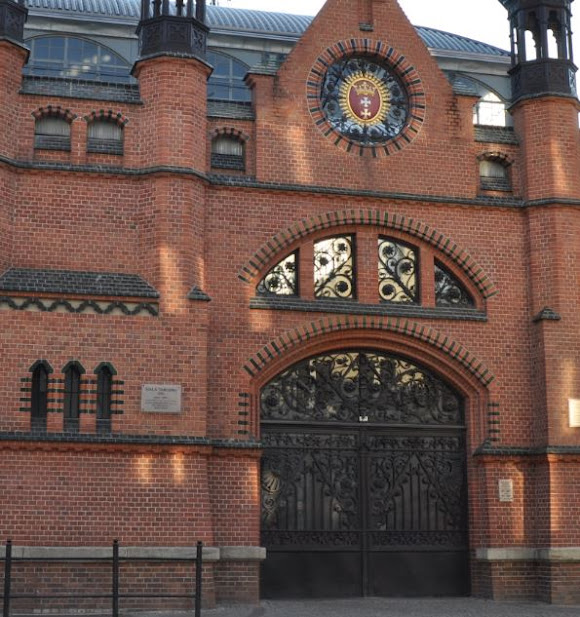
Hala targowa (the market hall)
The market hall in Gdansk is situated right behind Targ Weglowy (Coal Square), a few minutes from Dluga Street. It is a specific building from 1896 with red tiles, arched doors and windows as well as several turrets. In the middle ages, a church was situated right here and archaeological excavations have established that this was a popular burial place. The actual market building survived the drastic events of the 20th century almost without any damage.
The building has recently been through a profound renovation, and in 2005 it reopened with a beautifully refurbished facade, new stalls and a cool image. Outside, stalls stand as before, one beside the other and very close to each other, selling groceries and other products of daily consumption.
I must admit that I liked the old market hall better when it was distinctly marked by the ravages of time and the booths were much more primitive than today, as in a way it was more human. Even though there is still a difference between them, in my opinion the market hall now resembles the huge shopping centres that can be found anywhere. But it still has an atmosphere, and if you are in Gdansk, it is something you must take a look at, at least because of the architecture.
The market hall has been arranged in three stories, with the basement being the most interesting, containing excavated parts of the church that stood at this place in the 13th century. It constitutes an interesting contrast to the modern, streamlined look of the shopping area. At the back we find a large number of flower shops specialising in elaborate bouquets for formal occasions.
The post office in Gdansk old town
The old post office in Gdansk has been immortalized by Gunter Grass in his master piece The Tin Drum, dealing with pre-war Gdansk. Gunter Grass has an excellent description of the episode where the post office in 1939 defends itself against the attack of German troops. The post office is located next to the harbour area in central Gdansk, and has now slightly fallen into disrepair. It is a large, square building with a certain beauty and a huge square in front of the building. The building also contains a museum, and in the square we find a statue commemorating the defenders of the post office, as well as a museum where you can learn about the history of the Polish postal service, which has roots back in the ancient mail coaches.
The fortification
Gdansk has been fortified and surrounded by moats since 1271 AD, whereas the city walls were built from 1343 AD. There isn’t too much left of the original fortification, but walking around the town you will find fragments of the old wall, and along the channel and at Targ Weglowy and several other places we can find old towers and fortifications, which functioned as a retreat for the defenders of the town.
The modern Gdansk
Gdansk has a cosy, sometimes slightly lazy, atmosphere of a port, but the town is being rapidly modernized. Walking around the town you will see modern, luxurious apartment and office blocks everywhere, rising high over the older buildings in Gdansk. New shops seem to be made by professional shop designers, and a growing number of international companies have representations in the town – from service centres to software development plants. Many Scandinavian companies have also found their way to Tri-City, from where it is relatively easy to get to Denmark and Sweden.
The town has always had a large number of bars and restaurants, but the development of the past decade has raised the level and the diversity of the restaurant business. Excluding a few exceptions, the infrastructure is nice, modern and well functioning not only in Gdansk itself but in the entire region. In spite of the modernity, the area throughout maintains its character and peculiarity; you feel that this may be Poland, but at the same time it is something else, and this “something else” may be more prevailing than the Polishness.
Please send an email to m@hardenfelt.pl if you would like an English-speaking tour guide to show you the most important places in Warsaw.
